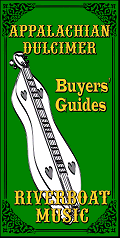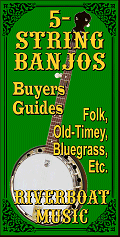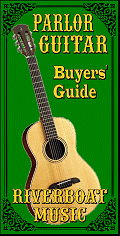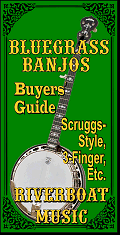Acoustic Instrument
Primers
What Kind of Guitar
Should I Start On?
What Kind of Banjo
Do I Want?
Evaluating and
Buying Used
Guitars
Setting Up
Fretted Instruments Whatever Happened
to the Banjo?
Beginning Five-
String Banjo
6-String Banjos
Banjo Pickups
Axes in my Life
What is a
Bluegrass Banjo?
Dean "Backwoods
Six" Shootout
Music Theory
Primers
Introduction
to Scales
Introduction
to Chords
Circle of Fifths
Other Articles
About Music
How to Give
Guitar Lessons
Musician or
Wannabe? Did God Really
Give Rock &
Roll to You?
Are You a
"Brand Bigot"?
Who Owns Folk Songs?
Historical Links
About the
National Road
The Story Behind
the Story - Real
People, Places,
and Events
About the Play
Play Home
What's New
Overview
About the
Music
About the
History
About the
Logistics
About the
Cast
Synopsis
About the
Set
About the
Author
Contact Us
Home




|

|



Beginning Five-String Folk Banjo - Part 10 - Raised Fifth Tuning (DBGDa)
| Written by Paul Race for Creek Don't RiseTM and School Of The RockTM |
This is a follow-up to our article on Standard ("C") banjo tuning, which hopefully helped you begin exploring the world outside of G tuning.
This lesson will introduce you to two more popular keys. Like the C tuning you learned last lesson, it requires only changing one string one step from G tuning. In this case, you raise the fifth string one step. Banjo players have been doing this for over a century, but they've never given this tuning a proper name yet, so I'm going to call it the "Raised Fifth Tuning" until somebody comes along with something better. From the string closest to your toes upward, the strings are tuned in DBGDa. (On internet forums, you'll often see this as aDGBD or even ADGBD, because they're counting from the string closest to their chins downward. Don't get confused.)
The main advantage this gives you is the ability to play in the key of D. D is the favorite key of most acoustic guitar players, because it's the easiest key for them. It also allows baritones and altos to sing most songs in a comfortable range. Folk, Country, and Alternative players have made wide use of this key. In other words, if you are going to be teaming up with a guitar player, the ability just to play along in D will put you way ahead of the game.
As a side effect, the Raised Fifth Tuning lets you play a lot of songs in A, although you won't be playing many fancy solos, since the A chord itself is a barre chord.
Still, if you're playing "out" and some mandolin player starts "Rocky Top" in A, you won't have to stumble back, redfaced, to your banjo case and look for a capo. Or worse yet, drop out altogether. Wank that fifth string up to an A note and take off.
In a future lesson, I'm going to explain how many pro banjo players, often with specially-equipped banjos, can play in even stranger keys easily. But if you get out of this lesson (and the previous lessons) with the ability to join along on songs in A, D, G, and C, you've literally quadrupled your chances of teaming up with a guitar player, or joining a guitar-based group, or "hanging in there" on jams when all the OTHER five-string learners have dropped out because of the key.
D and A accompaniments are a "Piece of Cake" - I've decided I like DBGDa tuning a lot. It allows you to play accompaniments in D or A easily without retuning anything but that pesky 5th string.
Dno3rd Option Offers Interesting Tonality - If you're playing in D, you have the option of playing a D WITHOUT a third. The open fifth gives a sort of modal feel like you get on some Appalachian dulcimer songs. Also, nobody can tell if your song is major or minor unless other parts come in, a characteristic not only of three-century-old Appalachian ballads, but also of several Fleetwood Mac songs. And whether you're playing in A OR D, that Dno3rd chord helps you get through really fast chord changes.
"Open G Chord" Still Works After a Fashion - If you're playing in D and you go up to G but leave the fifth string open, you're really playing a G9 chord. You'll discover that it sounds pretty nice. It makes an easy substitute for a straight G chord. (Acoustic guitar players playing in G substitute C9 for C all the time and you never noticed. This is the same principle.)
If you're playing in A, you'll discover that it's easy to substitute E7sus4 for E7 in most songs. This is the same principle as when we were playing in G and substituted D7sus4 for D7.
This tuning also makes it a piece of cake to play songs in Am or Dm, which we'll address in a future lesson.
When I'm playing in D or Dm, that low tonic gives a gutsy kick to the part that you just don't get when you're playing in G.
The other chords are similar to chords you already know. I know the D looks strange to you after all those weeks or months of playing D7sus4. But you may remember that I did introduce a D chord to you all the way back in Lesson 1. I told you to forget about it until later. Well, now it's later.
Just as G and C have three chords you're likely to use in every song, here are the three chords you're most likely to use when playing in the key of D, plus the Dno3rd which can be a very useful substitute for D or D minor.
Chords for the Key of D in DBGDa Tuning
Because DBGDa tuning is so close to G tuning (DBGDg), there's really only one new chord to learn: A. If you remember from your Circle of Fifths, A is to D as D is to G. It's the Fifth, the Dominant, or the V chord in the key of D.
1, or I |
(Alternative), 1, or I |
4, or IV |
5, or V |
 |
 |
 |
 |
Key of D Example: "Wreck of the Old 97"
To get you started in playing this tuning, we'll use a classic railroad tune that was recorded by Vernon Dalhart in 1924. That has since been called the first "Country" hit recording, although it wasn't called "Country" at the time. We'll start with two simple accompaniments to give you the gist of playing rolls in these patterns, then go into two versions of a banjo solo.By the way, if you learned the old Pete Seeger C to C6 hammering-on pattern in lesson 9, you'll discover that you use exactly the same pattern for the base line in this pattern. Only in this case, your fourth string is tuned to D, and when you fret the third string on the second fret, it actually makes a D chord.
Click the little icon to the right to hear this accompaniment played without the melody. 
To see printable sheet music, click on the staff below.

Dno3rd Example - Remember what I said about the Dno3rd chord? It's easier to play and has a different sound that is neither major nor minor. In fact, that makes it the perfect chord for some really old music that wanders back and forth.
In the roll shown below, you still play the first string, you just don't fret it. So it echos the second string. This provides a drone effect a little like an Appalachian dulcimer. The mp3s don't really give the effect, but when you try it with a real live banjo in your hands, you'll hear what I mean. In this version of the accompaniment, you don't hear much difference - you may not even like it as much as the version above. But if you keep going with this lesson, you'll discover how handy this chord is when you need to play at lightning speed.
Click the little icon to the right to hear this accompaniment played without the melody. 
To see printable sheet music, click on the staff below.

Doubletime Example - Depending on where you grew up, you may be thinking that the two examples above are way too slow. In fact, that's the way the song was sung 70 year ago. But Bluegrass has happened since, with its tradition of lightning-fast picking. So in most of the versions you hear today, the banjo is playing in "double time." This is almost exactly like the version above, except that the banjo part is played twice as fast.
Seventy years ago a "breakdown" in Appalachian music was a part of the song after the chorus and verses had been sung, on which the various musicians took turns taking solos. Keep in mind that most "working" musicians in those days were accompanying "barn dances" and the like. So if you could make a song last ten minutes instead of three, that meant you didn't have to learn as many songs, plus the vocalist would get a break. Not unlike some nightclub bands today.
With the rise in popularity of songs like Scruggs "Foggy Mountain Breakdown," it became conventional to pick up the speed for the "breakdown," the way Irish bands playing dance tunes like to raise the tempo every couple of verses to get folks dancing faster and faster.
Some folks say that Bill Monroe used to define a "breakdown" as a tune that was too fast to dance to, used by the band at a barn dance to signal that they were ending the set. At any rate, the name has come to mean "breakneck speed." And that's what you'll have to use to play the following version.
Incidentally, if you ever hear Johnny Cash's version of this, his bass guitar player plays his "bum-ditty" part at almost exactly this speed, though usually in a different key.
Click the little icon to the right to hear this accompaniment played without the melody. 
To see printable sheet music, click on the staff below.

Solos in D (DBGDa tuning) - So you've learned all eleven verses of the thing and sung it to death, but your buddies in the band won't let you get away without taking at least one "break" (Bluegrass for "solo"). We have a slow and breakneck, er, breakdown version for you to practice.
Remember, in all cases, our tablature is a suggestion only. Every banjo player will play every song a little bit differently. Worse yet, yours truly never plays the same song the same way twice. The main thing on "breaks" is that you give the general idea of the melody while filling in where you can with notes from your roll. Our arrangements are just to get you pointed in the right direction.
As one example, in measure 8, we use a combination of "pull-offs" to play all the notes in the measure while keeping some parts of the roll going to some extent. You don't have to do that. In the "breakdown" verion that follows, you just pick the melody notes, period. And that might work better for you in this version.
Click the little icon to the right to hear the (slow version) solo shown in the tab below
To see printable sheet music, click on the staff below.

Breakdown Solo Suggestion - The tab for a "breakdown" version is shown below. By the way, the mp3 file is a little slower than you will probably play this tune eventually - I just wanted you to be able to see how the notes fit the tune. Also, on this version, I used the full D chord, instead of the Dno3rd. If you're more comfortable with the Dno3rd chord in this song, or it helps you play faster, go for it.
If you never master this song in this tuning, no one will hate you. This is just another example of a way to use these roles and this tuning. And in the meantime, I hope you're getting comfortable with playing in the key of D.
On the other hand, you'd get a lot of "cred" out of playing the first solo, then breaking into the second one at the highest speed you can pull off consistently.
Click the little icon to the right to hear the (slow version) solo shown in the tab below
To see printable sheet music, click on the staff below.

Chords for the Key of A in DBGDa Tuning
Because you've already been dabling in DBGDa tuning, there's really only one new chord to learn: E and its variants. Especially E7sus4, which works exactly the same for the key of A as D7sus4 does for the key of G. If you remember from your Circle of Fifths, E is to A as A is to D. It's the Fifth, the Dominant, or the V chord in the key of A.Just as the keys of G, C, and D have three chords you're likely to use in every song, here are the three chords you're most likely to use when playing in the key of A, plus the Dno3rd which can be a very useful substitute for D.
1, or I |
4, or IV |
(Substitute) 4, or IV |
5, or V |
 |
 |
 |
 |
Key of A Example: "Boil That Cabbage Down"
I know, by now you should be able to play the bejeebers out of this tune in the key of G. I just wanted to show you that the key of A is nothing to be frightened of. In fact I play some pretty complex songs in A, but they're covered by other people's copyrights and they're out of scope for this tutorial.We'll start with a simple accompaniment, so you can get used to the chords.
Click the little icon to the right to hear this accompaniment played without the melody. 
To see printable sheet music, click on the staff below.

"Boil That Cabbage" Simple Solo in A - Now we'll go to the A version of the first solo we ever showed you (which was in G). It should be very familiar by now. In fact, your right hand plays almost exactly the same thing it plays when you play this song in G. True, "blue notes" are a little tougher.
Click the little icon to the right to hear this version of the solo played in A.
To see printable sheet music, click on the staff below.

Conclusion
Now, most folks won't choose to solo most of the time in the keys of D or A. But being able to accompany in those keys gives you a lot more flexibility than most beginning banjo players have. And hopefully a greater sense of how chords go together to make songs - something that will help your songwriting and your ability to interpret other people's songs, and even your ability to play in yet stranger keys, which is one mark of a professional. (We will explain more about that in our next lesson.)In the meantime please contact us if you have any questions or hit any brick walls.
All material, illustrations, and content of this web site is copyrighted © 2001, 2002, 2003, 2004, 2005, 2006,
2007, 2008, 2009, 2010, 2011, 2012, 2013, 2014, 2015 by Paul D. Race. All rights reserved.
Creek Dont' Rise(tm) is a participant in the Amazon Services LLC Associates Program, an affiliate advertising
program designed to provide a means for sites to earn advertising fees by advertising and linking to Amazon.com.
For questions, comments, suggestions, trouble reports, etc. about this play or about this web page, please contact us.
| Visit related pages and affiliated sites: | ||||||
| - Music - | ||||||

|
 |
 |

|

|

|
|

|

|

|

|

|

|
|
| - Trains and Hobbies - | ||||||
 |

|

|  |
 |

|
|
| - Christmas Memories and Collectibles - | ||||||
 |

|
 |

|
 |

|
|
| - Family Activities and Crafts - | ||||||
 |

|

|

|

|

|
|
